Where to See Bison in Yellowstone National Park
The fact that American bison aren’t extinct in the United States is largely thanks to Yellowstone National Park.
These extraordinary animals, a very symbol of American wilderness, came perilously close to extermination in the 19th century, but were able to find a safe haven in national parks like Yellowstone.
Particularly the Lamar Buffalo Ranch, established in 1907, played a crucial role in the survival of bison in Yellowstone—and therefore in the United States as a whole.
Now, Yellowstone National Park is “the only place in the United States were bison have lived continuously since prehistoric times,” the National Park Service says. The bison of Yellowstone are remarkable for another reason, too: they are the country’s largest bison population on public lands.
Contrary to bison herds elsewhere, Yellowstone bison can roam virtually freely across the vast landscapes of this sprawling national park in Wyoming and Montana.
It’s one of a few herds in the world that still show wild behaviors much like their ancient ancestors did, such as seasonal migrations, exploration in search of new habitat, and congregation during breeding season.
In fact, it’s due to those ancient behaviors, combined with preservation projects at the aforementioned Lamar Buffalo Ranch, that the Yellowstone bison managed to survive, forming the basis of the species’ successful restoration in the park and beyond.

This is all to say that watching wild bison in Yellowstone National Park is a unique experience, which, if things had gone only slightly differently, might not have been possible at all.
So, thankfully, it is still very much possible to see bison in Yellowstone National Park. Even more so, bison viewing in Yellowstone is arguably the best in the world.
Nowhere else is it this easy to see these majestic mammals in their natural historical habitat.
This blog post about the best places to see bison in Yellowstone National Park contains affiliate links. You can read more about our Terms of Use / Disclosure here.
6 Best Places to See Bison in Yellowstone National Park
The importance of Yellowstone National Park is hard to exaggerate, especially when it comes to wildlife conservation.
In addition to bison, the park is also world-famous for its thriving populations of grizzly bears, black bears, gray wolves, bighorn sheep, elk and moose.
If you’re planning a trip to Yellowstone and are wondering where the best places are to see bison in Yellowstone National Park, you’ll find them below!
1. North Entrance and Roosevelt Arch
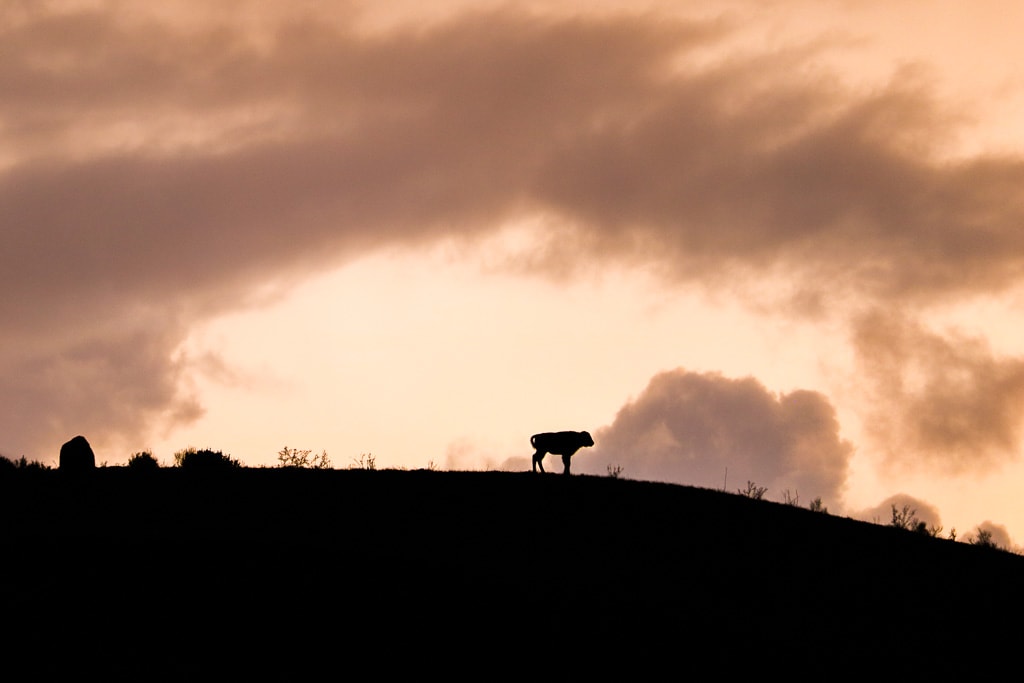
One of the most iconic landmarks in Yellowstone stands near the North Entrance. Located in the gateway town of Gardiner, the imposing Roosevelt Arch was the first major entrance to Yellowstone National Park.
The arch was built over the main road from Gardiner, Montana to the Yellowstone National Park headquarters in Mammoth, Wyoming.
President Theodore Roosevelt visited Yellowstone when the arch was being constructed in 1903, laying its cornerstone—the construction was subsequently named “Roosevelt Arch.”
Nowadays, you can still drive through the Roosevelt Arch with your own car, which is a must-do activity when visiting Yellowstone.
Behind the arch and on the barren hills surrounding the modern-day North Entrance, you can often see bison and elk grazing.
Additionally, paralleling the Gardner River, the road between Mammoth Hot Springs and the North Entrance is a great place to see bison and all kinds of other Yellowstone wildlife, too.
2. Tower-Roosevelt

The heart of Yellowstone’s Northern Range, Tower-Roosevelt is known for its spectacular mountainscapes and abundance of wildlife.
This is where the west-flowing Lamar River meets the north-flowing Yellowstone River, a beautiful area characterized by dense forests, wide open plateaus, small lakes and streams.
The area extends from Blacktail Deer Plateau to just beyond the bridge across the Yellowstone River. Drive a bit further east and you’ll arrive in the majestic Lamar Valley (see below).
Bison can be seen in the greater Tower-Roosevelt area year-round. It’s essentially in the middle of a major bison migration route, which runs between the Lamar Valley and their winter range north of Mammoth Hot Springs.
In addition to bison, you can also find huge herds of elk here, along with especially dense populations of black bears, bighorn sheep, and a couple of wolf packs.
3. Mammoth Hot Springs
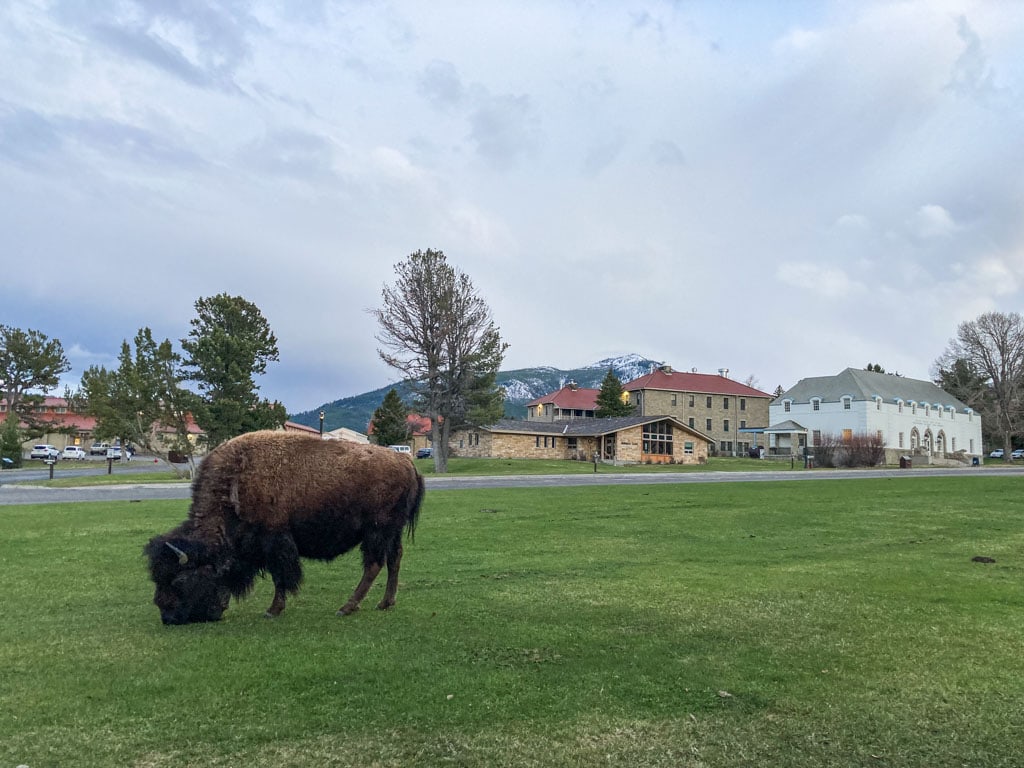
Located in the northwestern corner of Yellowstone National Park, near the Gardner River, Mammoth Hot Springs attracts both people and wildlife.
A network of boardwalks allows visitors to see the area’s stunning travertine terraces from up-close, while a variety of animals find refuge in its relatively warm environment. The surrounding hills provide sustenance to large herds of elk and bison.
Even the bustling lawns of Mammoth Hot Springs are a great place to see bison in Yellowstone.
This is where you’ll find many visitor facilities and attractions, from the Albright Visitor Center and Mammoth Hot Springs Hotel to historic Fort Yellowstone and the Mammoth Post Office.
Especially in the early morning or late afternoon, it’s not uncommon to see numerous bison munching on the succulent grass of Mammoth’s lawns.
I’ve seen them all over this area, including Albright Avenue, the Parade Grounds and among the buildings of Fort Yellowstone.
If you’re staying in Mammoth Hot Springs, this is arguably the easiest place to watch wild bison in Yellowstone National Park. And if, somehow, there aren’t any bison around, chances are pretty high you’ll be able to see elk instead.
4. Firehole Valley

The Firehole River is one of the main rivers in western Yellowstone National Park, flowing from south of Old Faithful to its confluence with the Madison River.
On its way, it passes by several of Yellowstone’s famous hydrothermal areas, from the Upper Geyser Basin to the Midway and Lower Geyser Basins.
Thanks to that hydrothermal activity, many areas in the Firehole Valley have thin snow cover throughout winter, which makes this an excellent overwintering place for bison, as well as elk.
You can see bison here throughout the entire year, even at extremely busy locations like Old Faithful, around the iconic Old Faithful Inn, and at Grand Prismatic Spring.
On a drive along the gorgeous Firehole River, as well as on hikes in the area, bison sightings are very common. In spring, keep an eye out for grizzly bears, who are attracted by the carcasses of winter-killed bison.
5. Hayden Valley
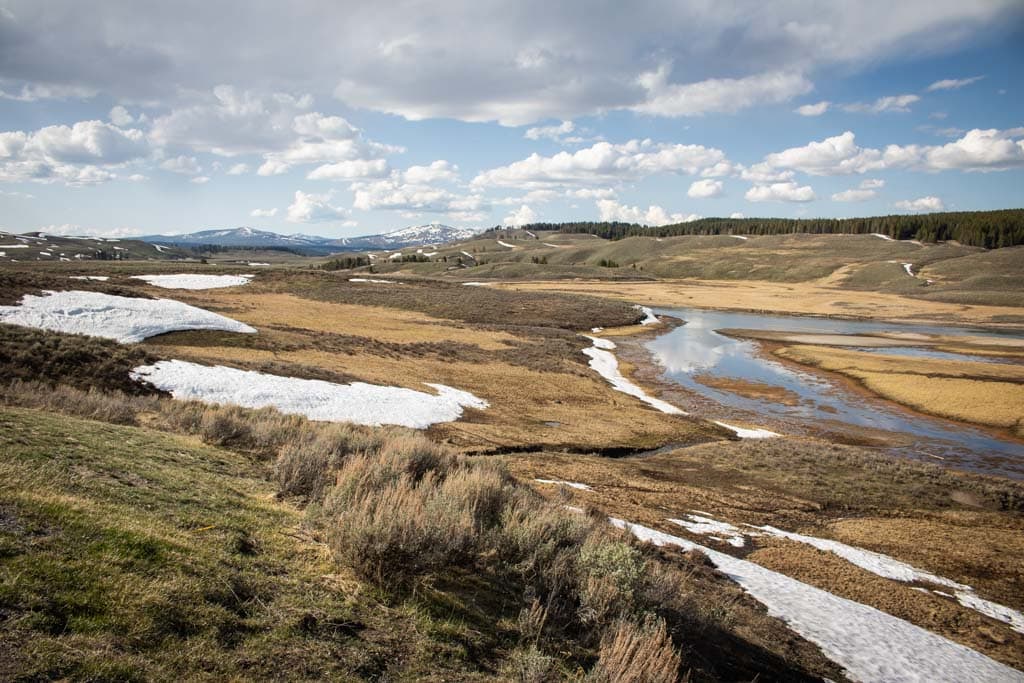
Situated just south of the Grand Canyon of the Yellowstone, the Hayden Valley is unquestionably one of the best areas to see bison year-round in Yellowstone National Park.
Once part of Yellowstone Lake, this picturesque valley is sliced in half by the Yellowstone River, its plains and ponds home to large of bison, as well as elk, pronghorn, moose, cranes, swans, pelicans and geese.
This is one of the best places to visit in Yellowstone National Park for wildlife. Although animals abound here throughout the entire year, your viewing opportunities are best in summer.
From June through August, spend an afternoon here to see the above-mentioned elk and bison, but also grizzly bears and wolves.
In August, bison from all over the region gather in Hayden Valley for the annual rut, the breeding season, a spectacle you should not miss in Yellowstone.
6. Lamar Valley
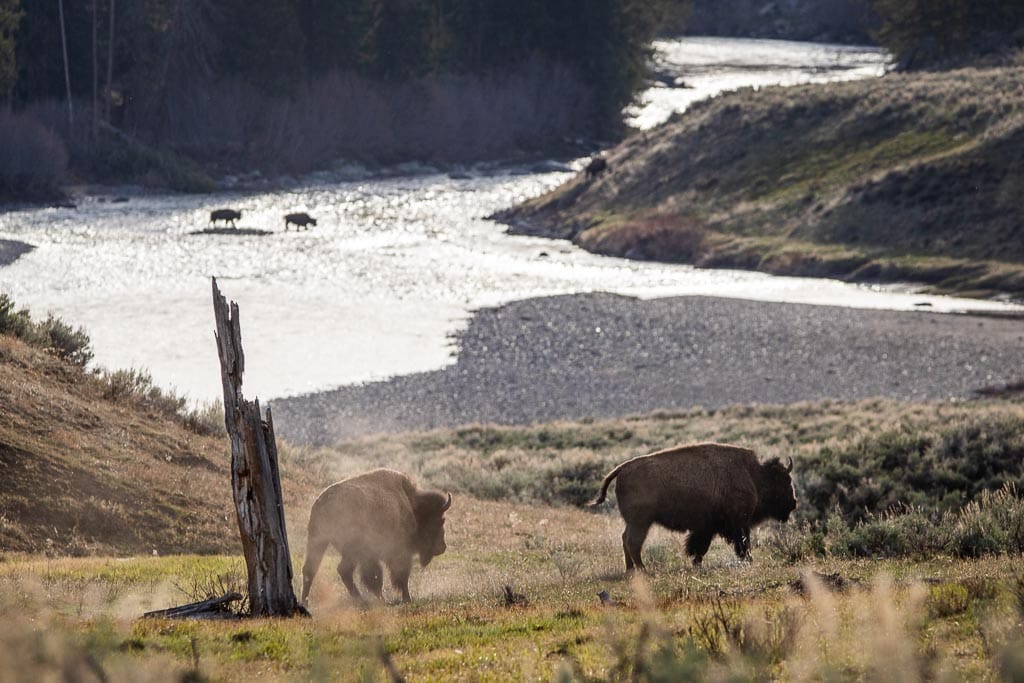
Home to massive numbers of megafauna, the grasslands of Yellowstone’s Northern Range are often called “North America’s Serengeti.”
The entire Lamar Valley in the park’s northeast is a wildlife paradise and the best place to see numerous iconic Yellowstone animals.
The Lamar River cuts through this vast valley, its relatively low elevation making it a preferred wintering range for immense herds of elk and bison. In fact, this is where you’ll find some of North America’s largest bison herds.
If you want to see bison in the wild, this is unquestionably one of the best places to go in Yellowstone, if not the best. Bison are present in the Lamar year-round.
In this sagebrush-covered valley, you can also see bighorn sheep and pronghorn (the fastest land animal on the continent).
The sheer abundance of prey animals attracts large numbers of predators to the Lamar Valley, too. Both black and grizzly bears are common sights, while coyotes, foxes and even mountain lions live here as well.
And that’s not all! The Lamar Valley is also home to several wolf packs, arguably the best place to see wolves in the wild on Earth.
The road across the Lamar Valley, between Tower Junction and Cooke City, just outside the park’s Northeast Entrance, is open throughout the entire year.
It offers truly world-class Yellowstone wildlife viewing opportunities in every season, especially for iconic national park mammals.
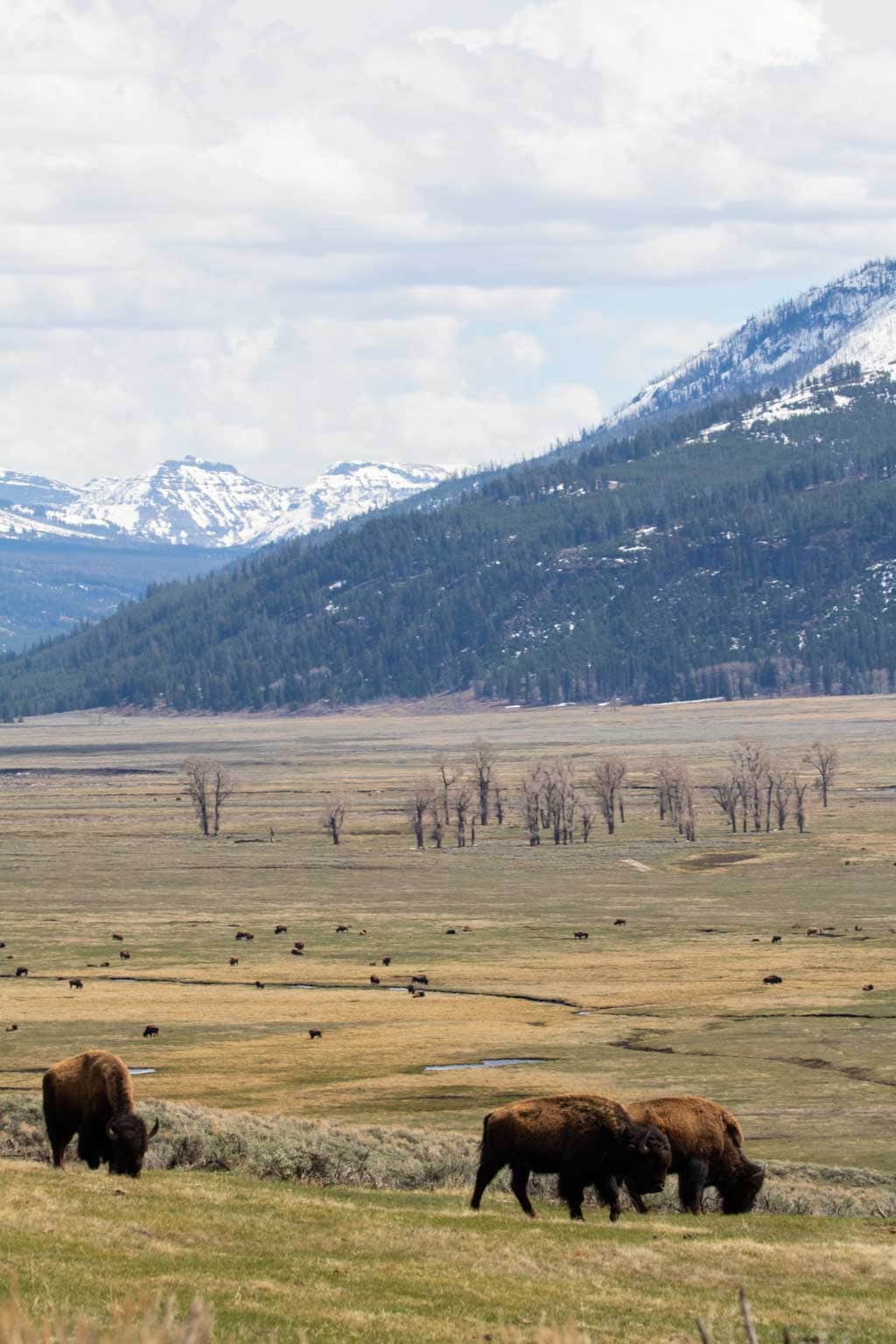
Where to See Bison in Yellowstone By Season
As mentioned above, the Yellowstone bison herds still exhibit ancient behaviors, including seasonal migrations in search of food, warmth, breeding grounds and shelter.
As such, the best places to see bison in Yellowstone tend to vary from season to season, as the herds move from place to place.
However, there are some areas, especially the park’s expansive river valleys, that are home to bison herds throughout the year.
- Winter: Firehole Valley, Madison River, Blacktail Deer Plateau, Tower-Roosevelt and the Gardiner Basin, Hayden Valley and Lamar Valley
- Summer: Blacktail Deer Plateau, Tower-Roosevelt, Firehole Valley, Hayden Valley and Lamar Valley
- Year-round: Firehole Valley, Hayden Valley and Lamar Valley
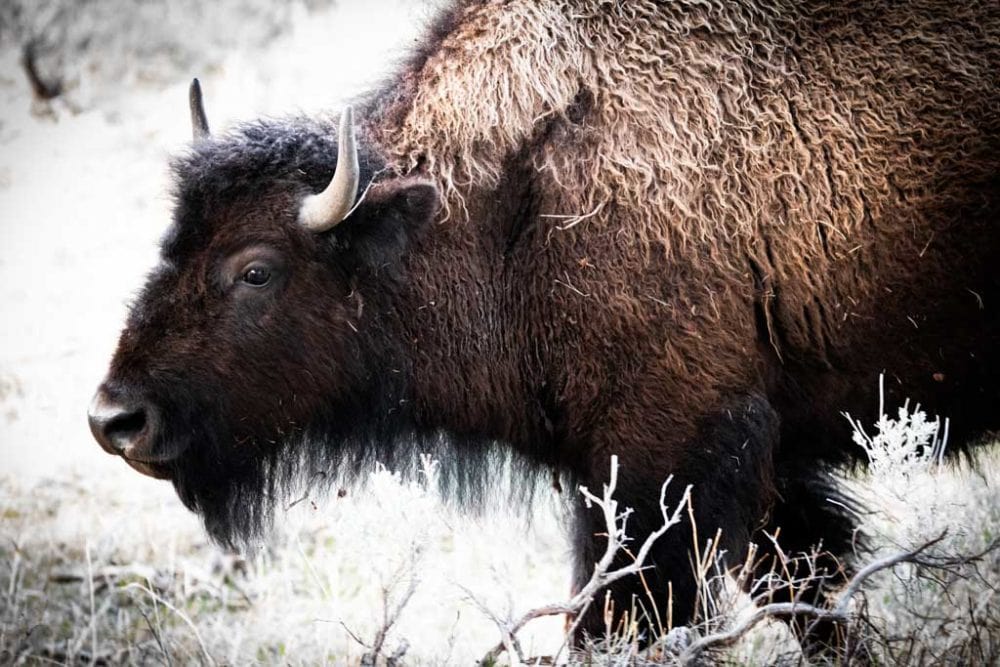
Bison Safety in Yellowstone National Park
As calm and aloof as wild bison may appear, they can be exceptionally dangerous. Almost every year, careless visitors are severely injured by bison.
In fact, according to the National Park Service, “bison have injured more people in Yellowstone than any other animal. Bison are unpredictable and can run three times faster than humans.”
Park regulations prohibit visitors from getting closer than 25 yards to a bison. I repeat: you must stay at least 25 yards from bison in Yellowstone National Park.
For more tips and information about bison safety, I recommend reading this blog post.






